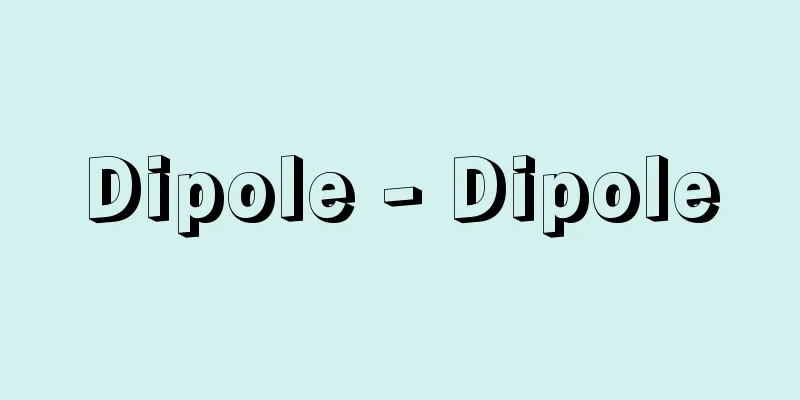Dipole - Dipole

|
Consider a pair of two monopoles, +q and -q, of equal magnitude and opposite sign. Let M be the position vector from -q to +q, and let m be the length of M. If the magnitude p of vector p = q・M remains constant when q → ∞ and m → 0, then this pair of monopoles is called a dipole, and p is called the dipole moment. A dipole creates a dipole field in the surrounding space. It is uniquely derived from the potential determined at position r = p・r/r 3. is called the dipole potential. The above is a mathematical definition, but physically, such a pair of monopoles does not necessarily correspond to reality. In any system, regardless of the charge distribution, if a field determined by the same potential as above is observed at a location more than a certain distance from the system, this can be considered and treated as a single dipole. In general, when the distribution of electric charge has a certain direction in space or time, that charge distribution creates a dipole field. In the spatial case, the dipole is an electric field and the charge distribution can be thought of as an electric dipole, in the temporal case, i.e. when the charge distribution is moving like a current, the dipole field is a magnetic field and such a system can be thought of as a magnetic dipole. Molecules with low symmetry generally have electric dipoles. Such dipoles resulting from the molecular structure are called permanent dipoles. In contrast, dipoles that arise when an external electric field is applied to a molecule or atom, distorting the spatial distribution of electrons, are called induced dipoles. Although the internal state of many elementary particles is unknown, they create a magnetic dipole field around them, and can be considered to be magnetic dipoles. The magnetic dipoles of elementary particles have an intrinsic moment determined by the type of elementary particle, specifically called spin. [Hiroshi Yasuoka] [Reference] | |Source: Shogakukan Encyclopedia Nipponica About Encyclopedia Nipponica Information | Legend |
|
大きさが等しく符号が反対の二つの単極+q、-qの組みを考えて、-qから+qへの位置ベクトルをM、Mの長さをmとする。q→∞、m→0のときにベクトルp=q・Mの大きさpが一定に保たれるなら、この単極の組みを双極子とよび、pを双極子のモーメントという。双極子は周囲の空間に双極子場をつくる。それは位置rで定まるポテンシャル=p・r/r3から一意的に導かれる。を双極子ポテンシャルとよぶ。以上は数学的定義であるが、物理的にはかならずしもこのような単極の対(つい)が現実に対応しているわけではない。どんな系でも、電荷分布のようすにかかわらず、そこからある程度以上隔たった場所で前記と同一のポテンシャルで定まる場が観測されれば、これを一つの双極子と考えて取り扱うことができる。一般に、電荷の分布が空間的または時間的に一定の向きをもつ場合、その電荷分布は双極子場をつくる。空間的な向きの場合、双極子は電場であって、電荷分布を電気的双極子と考えることができる。時間的な向きの場合、すなわち電流のように電荷分布が動いている場合には双極子場は磁場であって、このような系を磁気双極子と考えることができる。 対称性の低い分子は一般に電気双極子である。このように分子の構造に起因するものを永久双極子という。これに対して、分子や原子に外部から電場をかけて電子の空間分布をゆがめることによって発生する双極子を誘起双極子という。多くの素粒子は、その内部のようすが未知であるけれども、周囲に磁気的な双極子場をつくっているので、これを磁気双極子と考えることができる。素粒子の磁気双極子は、素粒子の種類によって定まった固有のモーメントをもっており、とくにスピンとよばれる。 [安岡弘志] [参照項目] | |出典 小学館 日本大百科全書(ニッポニカ)日本大百科全書(ニッポニカ)について 情報 | 凡例 |
<<: Hyperbola - soukyokusen (English spelling)
>>: Hyperbolic equation - soukyokugatahotei-shiki (English spelling) hyperbolic equation
Recommend
Oshikise - Oshikise
... Cotton clothing, obi, juban, apron, geta, etc...
Crane Trick - Crane Trick
...The wings have finely branched veins at the ti...
Dipsacus fullonum (English spelling) Dipsacusfullonum
…[Mr. Makoto Fukuoka]. … *Some of the terminology...
Shaanxi Province - Teacher
A province in central China. Its capital is Xi'...
castella
…The area stretches from the Bay of Biscay in the...
Pleural cavity
The part of the thoracic cavity excluding the medi...
Antisthenes - Antisthenes (English spelling)
An ancient Greek ascetic philosopher. A student o...
Telophorus quadricolor (English spelling) Telophorusquadricolor
… There are about 40 species distributed in Afric...
Invaginated Kiss - Kannyuufun
…The proboscis of kinorhyncha, nematodes, helmint...
Heterotrephes admorsus (English spelling) Heterotrephes admorsus
… Stink bugs with the name water bug include the ...
thunderstorm cell
...the height of a thundercloud, expressed as its...
Dewa Province - Dewa no Kuni
The former name of the area that is now Yamagata ...
Mesopotamian Art
Art from the Mesopotamian region (which spans mos...
Elizabeth McIntosh
…British female author. Her real name is Elizabet...
phase shift keying
…On the other hand, when the modulating signal is...









